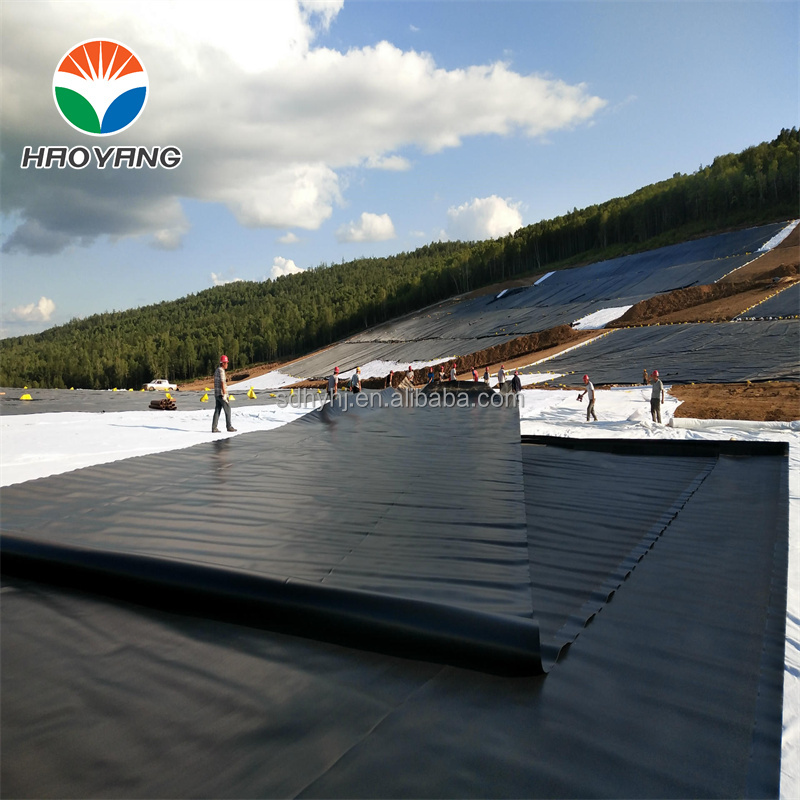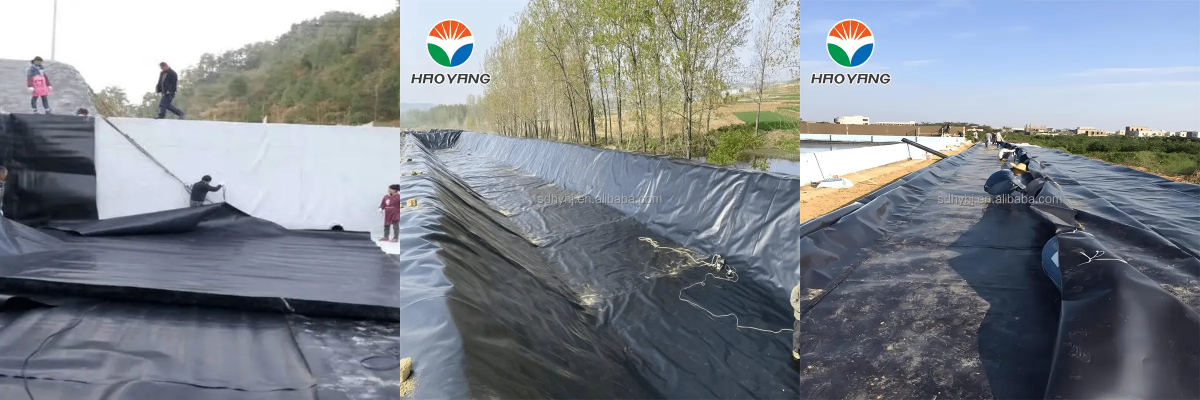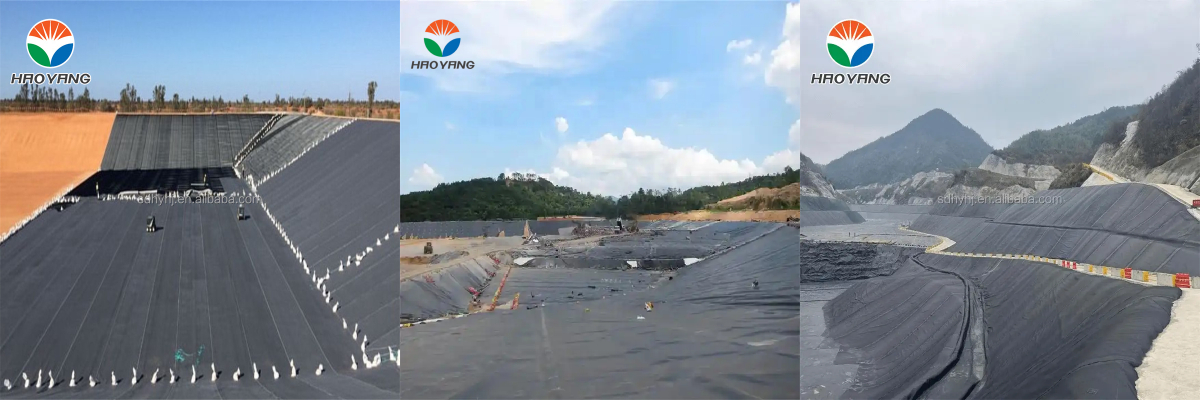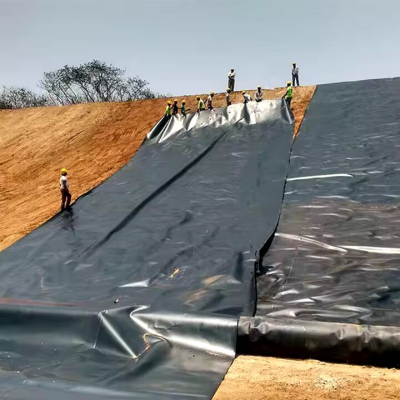Virgin 100% 0.5mm HDPE Geomembrane
1.Superior Durability & Longevity
Made from 100% virgin HDPE resin with advanced antioxidants, achieving 300% higher environmental stress cracking resistance than recycled materials.
2.Cost-Effective & Low Maintenance
60% lower initial cost compared to concrete liners (e.g., 0.8−1.5/m2vs.2.5-3.0/m² for concrete).
3.High Performance & Environmental Adaptability
92% retained strength after 5,000 hours of UV exposure, ensuring reliability in open-air installations.
Virgin 100% 0.5mm HDPE Geomembrane: A High-Performance Solution for Modern Engineering Challenges
In the fields of hydraulic engineering, environmental remediation, and agricultural infrastructure, the selection of impermeable materials directly impacts project longevity and operational costs. As a next-generation synthetic barrier solution, Virgin 100% 0.5mm HDPE Geomembrane has emerged as a superior alternative to traditional concrete and clay liners. This article examines its material properties, technical specifications, and industry applications through three core dimensions.
I. Material Characteristics: Molecular-Level Purity Drives Performance
1. Raw Material Composition & Formulation
Constructed from 100% virgin high-density polyethylene (HDPE) resin sourced from global chemical leaders, the material maintains a carbon black content of 2.0-3.0% with precise additives including antioxidants, UV stabilizers, and thermal aging inhibitors. This formulation achieves a 300% improvement in Environmental Stress Cracking Resistance (ESCR) compared to recycled-content alternatives, maintaining <0.02mm/year creep rate under -40°C to 80°C extremes. A Southeast Asian aquaculture project demonstrated a 97.5% reduction in pond leakage (from 12% to 0.3%) using this material, saving over $30,000 annually in water costs.
2. Physical Property Comparison
| Parameter | Test Standard | Virgin 0.5mm HDPE | Recycled HDPE | Improvement |
Tensile Strength (MD/TD) | ASTM D638 | 20MPa/18MPa | 12MPa/10MPa | 67% |
Puncture Resistance | ASTM D4833 | 360N | 180N | 100% |
Elongation at Break | ASTM D882 | 600% | 400% | 50% |
Water Vapor Permeance | ASTM E96 | 0.05g/(m²·24h) | 0.2g/(m²·24h) | 75% |
3. Surface Engineering Innovations
Dual-sided textured patterns increase the friction angle from 28° (smooth) to 42°, enhancing slope stability by 2.3x on 1:1.5 landfill side slopes. A Northwest China tailings dam project reduced protective layer thickness by 40% while shortening construction by 15 days through this design.
II. Technical Advantages: Three Core Value Propositions
1. Total Cost of Ownership Optimization
Capital Expenditure: $0.8-1.5/m² for 0.5mm thickness (60% lower than 2mm concrete)
Maintenance: 30-50 year service life with zero repair requirements
Energy Efficiency: 80% lower CO₂ emissions vs. concrete (1.8 vs. 9.0 tons CO₂ per equivalent impermeable area)
2. Construction Productivity Gains
Welding Speed: 8m/min with hot-air technology (3x faster than extrusion welding)
Flexibility: Minimum bend radius of 0.3m for complex topographies
Material Efficiency: <3% field trimming waste (vs. 15% for prefabricated concrete)
3. Environmental Resilience
UV Stability: 92% retained strength after 5,000 hours accelerated aging
Chemical Resistance: <0.5% mass loss after 180-day exposure to pH 2-12 solutions
Biological Resistance: ISO 846 Grade 0 algae growth inhibition
III. Application Scenarios & Technical Specifications
1. Aquaculture Systems
| Application | Thickness | Special Requirements | Performance Metrics |
Marine Recirculation | 0.5mm | Chloride resistance | 35% water savings |
Freshwater Farms | 0.5mm | Root penetration barrier | 18% higher survival rate |
Industrial Systems | 0.75mm | Disinfectant resistance | 5-year maintenance cycle |
A shrimp farming complex in Ecuador achieved 22% higher yield and 40% lower construction costs (80,000vs.120,000 per hectare) using 0.5mm textured geomembranes, while reducing water exchange from 6x to 2x daily.
2. Environmental Engineering
In hazardous waste landfills, composite liners combining 0.5mm HDPE with GCL bentonite achieve 1×10⁻¹² cm/s permeability – three orders of magnitude superior to clay liners. A chemical industrial park in China maintained Class III groundwater quality over five years using this system.
3. Hydraulic Infrastructure
Canal lining projects report 15% → 3% seepage loss and 25% increased flow capacity with 0.5mm HDPE. A Xinjiang irrigation district saved 4 million m³ annually, equivalent to restoring 1,333 hectares of arable land.
IV. Technological Evolution & Industry Standards
ASTM GRI-GM13 now mandates 0.5MPa hydrostatic pressure resistance for 0.5mm geomembranes (up from 0.3MPa), driving innovation in high-strength formulations. Nanotube-enhanced materials have achieved >30MPa tensile strength, enabling 0.3mm ultra-thin designs.
In smart construction, laser welding robots paired with AI quality inspection systems have raised welding pass rates from 92% to 99.7% while boosting productivity by 40%. A global contractor reduced project durations by 22% and material waste to 1.8% through digital construction management.
Conclusion
Virgin 100% 0.5mm HDPE Geomembrane redefines engineering barriers through molecular-level material innovation and process optimization. Its cost efficiency, construction agility, and environmental resilience are transforming water management, pollution control, and sustainable agriculture. As nanotechnology and smart manufacturing converge, this material will play an increasingly critical role in global infrastructure development.












